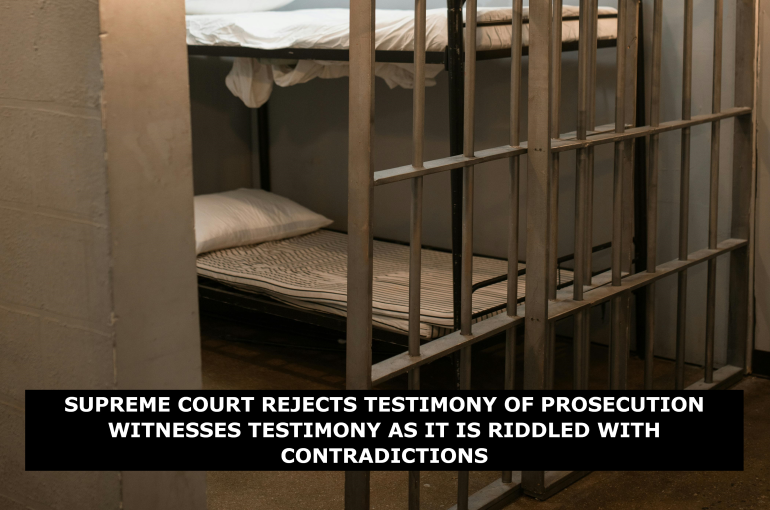SUPREME COURT REJECTS TESTIMONY OF PROSECUTION WITNESSES TESTIMONY AS IT IS RIDDLED WITH CONTRADICTIONS
A two-judge bench of the Supreme Court comprising of Justice Abhay S. Oka and Justice Ujjal Bhuyan passed a Judgment dated 04-02-2025 in the matter of Ramu Appa Mahapatar vs. the State of Maharashtra Criminal Appeal No. 608 of 2013 and observed while there is strong suspicion against the Appellant that point to his being guilty of murder, it is a well-established principle that suspicion, no matter how strong, cannot replace concrete evidence. The Prosecution’s case rests on an extra-judicial confession before certain witnesses, but due to its lack of credibility, it cannot be relied upon for conviction.
FACTS:
That the Appeal mentioned above was filed before the Supreme Court by one Ramu Appa Mahapatar (Appellant) against the State of Maharashtra (Respondent), that challenged the Judgment dated 02.12.2010 of the High Court of Bombay (High Court) in Criminal Appeal No. 252 of 2005 (Ramu Appa Mahapatar v. State of Maharashtra), which dismissed the Appellant’s Appeal.
The Appellant, lived with the deceased, Manda, in a live-in relationship. They resided in a chawl owned by PW-1, Ravindra Gopal Jadhav, the landlord. On the morning of 21.03.2003, the Appellant informed PW-1 that Manda had passed away and that he was leaving for Dipchale village to inform her relatives.
The Appellant, along with his son, visited Dipchale village and met PW-3, Bhagwan, the deceased’s brother. In the presence of PW-4 Chandabai, PW-5 Pandhari, and PW-6 Shankar, the Appellant admitted that he had quarrelled with Manda and assaulted her, leading to her death.
Before the Appellant returned with Manda’s relatives, PW-1 had already entered the house, which was bolted from the outside. Inside, he found Manda lying dead with multiple bleeding injuries. Her mangalsutra and bangles were broken, and household items were scattered around.
When the Appellant arrived with Manda’s relatives, PW-1 questioned him about the incident. The Appellant stated that Manda suspected him of having an illicit relationship, which led to a quarrel, during which he assaulted her with a grinding stone and a stick.
PW-1 lodged an FIR at the police station, leading to the registration of a case under Section 302 of the Indian Penal Code (IPC) against the Appellant.
The investigating officer conducted an inquest, prepared a spot panchnama, and seized various items from the crime scene. The police arrested the Appellant and recovered the alleged weapon of assault.
Upon completing the investigation, the police filed a chargesheet against the Appellant for the offence of murder under Section 302 IPC.
The Trial commenced before the First Ad-hoc Additional District and Sessions Judge, Thane, in Sessions Case No. 52 of 2004. The Prosecution examined ten witnesses to prove its case, primarily relying on the Appellant’s extra-judicial confession to PW-1, PW-3, PW-4, and PW-6.
On 15.10.2004, the Sessions Judge convicted the Appellant under Section 302 IPC, sentencing him to life imprisonment and imposing a fine of ₹1000/-, with a default sentence of three months’ rigorous imprisonment.
The Appellant challenged his conviction before the Bombay High Court in Criminal Appeal No. 252 of 2005. On 02.12.2010, the High Court dismissed the Appeal and upheld the conviction and sentence.
TRIAL COURT OBSERVATIONS:
The Trial Court relied primarily on the extra-judicial confession made by the Appellant before PW-1 (Ravindra Gopal Jadhav), PW-3 (Bhagwan), PW-4 (Chandabai), and PW-6 (Shankar). The Court considered these witnesses credible and accepted their testimonies.
The Court noted that the Appellant and the deceased lived together, and the Appellant was the last person seen with Manda before her death.
The Trial Court observed that Manda had multiple injuries, and the scene of the crime indicated a struggle. The broken mangalsutra and bangles, along with the scattered household items suggested a violent altercation.
The Court found that the Appellant himself informed PW-1 about Manda’s death and later admitted to PW-3 and others that he had assaulted Manda with a grinding stone and a stick following a quarrel.
The Prosecution failed to produce direct eyewitnesses, but the Court found the circumstantial evidence sufficient to hold the Appellant guilty.
The defense counsel’s argument that unknown persons had entered the house and assaulted Manda was not supported by any evidence, and the Court rejected this claim.
The Court concluded that the chain of circumstances pointed towards the guilt of the Appellant, and there was no reasonable doubt regarding his involvement in Manda’s murder.
Based on these findings, the Trial Court convicted the Appellant under Section 302 IPC and sentenced him to life imprisonment with a fine of ₹1000/-, with a default sentence of three months’ rigorous imprisonment.
HIGH COURT OBSERVATIONS
The High Court upheld the conviction of the Appellant under Section 302 IPC, agreeing with the Trial Court’s findings that the Prosecution had established a strong case based on circumstantial evidence.
The Court observed that the Appellant had admitted to the crime in his extra-judicial confession before PW-1 (Ravindra Gopal Jadhav), PW-3 (Bhagwan), PW-4 (Chandabai), and PW-6 (Shankar). The High Court found no reason to disbelieve these witnesses.
The Appellant’s conduct was deemed suspicious. He informed PW-1 about Manda’s death but did not immediately report the matter to the police. Instead, he travelled to Dipchale village to inform Manda’s relatives, which the Court found unusual.
The scene of the crime supported the Prosecution’s version. Manda was found dead with multiple injuries, and signs of a struggle were evident, including broken bangles, a damaged mangalsutra, and scattered household items.
The Appellant’s claim that some unknown persons had entered the house and assaulted Manda was not supported by any evidence. The High Court rejected this defense argument.
The Court noted that while extra-judicial confessions are a weak form of evidence, they can be relied upon if corroborated by other circumstances. In this case, the High Court found the confession credible and supported by circumstantial evidence.
The High Court dismissed the appeal on 02.12.2010, affirming the Trial Court’s judgment and life sentence.
ISSUES:
Whether the conviction of the Appellant under Section 302 IPC, based primarily on an extra-judicial confession and circumstantial evidence, was legally sustainable in the absence of direct evidence.
SUPREME COURT OBSERVATIONS:
The Supreme Court found that the Prosecution’s case relied primarily on an extra-judicial confession, which is a weak form of evidence unless corroborated. PW-3 admitted that the Appellant was in a confused state of mind when he allegedly confessed, casting doubt on its voluntariness and reliability. Additionally, key witnesses gave contradictory statements, and crucial details were missing from their police statements under Section 161 CrPC.
The Court noted that the Prosecution failed to establish a complete chain of circumstantial evidence. No forensic evidence, such as blood-stained clothes or a confirmed murder weapon, was presented, and no eyewitnesses directly linked the Appellant to the crime. The Court reiterated that mere suspicion, however strong, cannot replace proof beyond a reasonable doubt.
Given the contradictions in witness testimonies, the lack of corroborative evidence, and the weak evidentiary value of the confession, the Supreme Court held that the conviction was not legally sustainable. The Court set aside the judgments of the Trial Court and High Court, acquitted the Appellant, and ordered his immediate release.
CONCLUSION:
The Supreme Court set aside the conviction and sentence imposed by the Trial Court and affirmed by the High Court. The Court acquitted the Appellant and ordered his immediate release.
Sakshi Raghuvanshi
Senior Legal Associate
The Indian Lawyer
“Please log on to our YouTube channel, The Indian Lawyer Legal Tips, to learn about various aspects of the law. Our latest video, titled ‘Law on Ancestral Property,’ can be viewed at the link below:”





































Leave a Reply